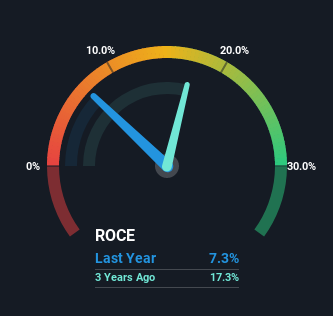- United Kingdom
- /
- Professional Services
- /
- AIM:GATC
Here's What's Concerning About Gattaca's (LON:GATC) Returns On Capital

If we're looking to avoid a business that is in decline, what are the trends that can warn us ahead of time? Businesses in decline often have two underlying trends, firstly, a declining return on capital employed (ROCE) and a declining base of capital employed. This combination can tell you that not only is the company investing less, it's earning less on what it does invest. In light of that, from a first glance at Gattaca (LON:GATC), we've spotted some signs that it could be struggling, so let's investigate.
Understanding Return On Capital Employed (ROCE)
Just to clarify if you're unsure, ROCE is a metric for evaluating how much pre-tax income (in percentage terms) a company earns on the capital invested in its business. The formula for this calculation on Gattaca is:
Return on Capital Employed = Earnings Before Interest and Tax (EBIT) ÷ (Total Assets - Current Liabilities)
0.073 = UK£2.6m ÷ (UK£90m - UK£54m) (Based on the trailing twelve months to January 2022).
Thus, Gattaca has an ROCE of 7.3%. Ultimately, that's a low return and it under-performs the Professional Services industry average of 15%.
See our latest analysis for Gattaca

Above you can see how the current ROCE for Gattaca compares to its prior returns on capital, but there's only so much you can tell from the past. If you'd like, you can check out the forecasts from the analysts covering Gattaca here for free.
What Does the ROCE Trend For Gattaca Tell Us?
The trend of returns that Gattaca is generating are raising some concerns. The company used to generate 15% on its capital five years ago but it has since fallen noticeably. On top of that, the business is utilizing 63% less capital within its operations. The fact that both are shrinking is an indication that the business is going through some tough times. If these underlying trends continue, we wouldn't be too optimistic going forward.
While on the subject, we noticed that the ratio of current liabilities to total assets has risen to 60%, which has impacted the ROCE. Without this increase, it's likely that ROCE would be even lower than 7.3%. What this means is that in reality, a rather large portion of the business is being funded by the likes of the company's suppliers or short-term creditors, which can bring some risks of its own.
Our Take On Gattaca's ROCE
In summary, it's unfortunate that Gattaca is shrinking its capital base and also generating lower returns. Unsurprisingly then, the stock has dived 75% over the last five years, so investors are recognizing these changes and don't like the company's prospects. Unless there is a shift to a more positive trajectory in these metrics, we would look elsewhere.
Gattaca does come with some risks though, we found 3 warning signs in our investment analysis, and 1 of those can't be ignored...
While Gattaca may not currently earn the highest returns, we've compiled a list of companies that currently earn more than 25% return on equity. Check out this free list here.
If you're looking to trade Gattaca, open an account with the lowest-cost platform trusted by professionals, Interactive Brokers.
With clients in over 200 countries and territories, and access to 160 markets, IBKR lets you trade stocks, options, futures, forex, bonds and funds from a single integrated account.
Enjoy no hidden fees, no account minimums, and FX conversion rates as low as 0.03%, far better than what most brokers offer.
Sponsored ContentNew: Manage All Your Stock Portfolios in One Place
We've created the ultimate portfolio companion for stock investors, and it's free.
• Connect an unlimited number of Portfolios and see your total in one currency
• Be alerted to new Warning Signs or Risks via email or mobile
• Track the Fair Value of your stocks
Have feedback on this article? Concerned about the content? Get in touch with us directly. Alternatively, email editorial-team (at) simplywallst.com.
This article by Simply Wall St is general in nature. We provide commentary based on historical data and analyst forecasts only using an unbiased methodology and our articles are not intended to be financial advice. It does not constitute a recommendation to buy or sell any stock, and does not take account of your objectives, or your financial situation. We aim to bring you long-term focused analysis driven by fundamental data. Note that our analysis may not factor in the latest price-sensitive company announcements or qualitative material. Simply Wall St has no position in any stocks mentioned.
About AIM:GATC
Gattaca
A human capital resources company, provides contract and permanent recruitment services in the private and public sectors.
Flawless balance sheet slight.
Similar Companies
Market Insights
Community Narratives



